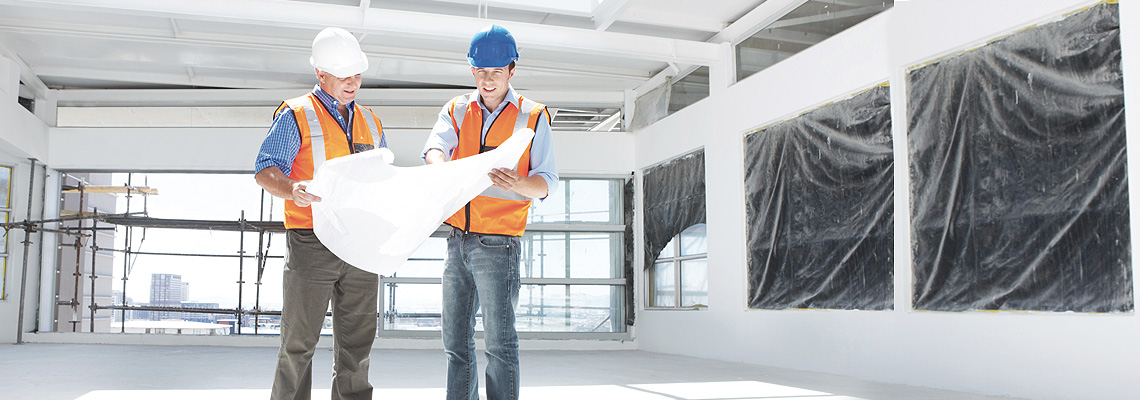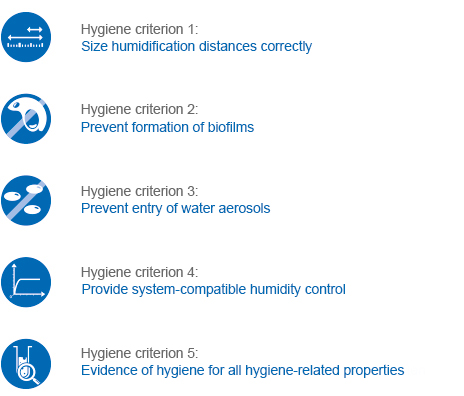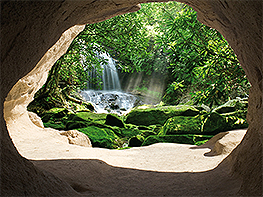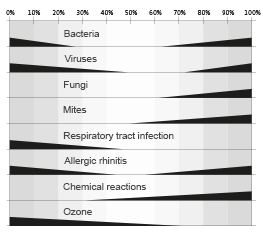
Planning guidelines for a hygienic humidification
Air Conditioning in the Stone Age and Today
If we look back to the beginnings of building services engineering, we see that air-conditioning equipment was already available very early on. Before man even learned to build huts and houses, man sought protection in caves from the elements. These dwellings were not very homely. However, if there was a fire burning in the cave entrance, the inhabitants were safe from wild animals and the cold could be held off at least in a makeshift manner. This was how the first heating system dependent on the air in the room and serving as door air curtain was born. Although important regulations such as the Ordinance on Furnace Installations were unknown, adequate flow of combustion air and at least a reasonably acceptable flue gas exhaust from the living area had to be ensured.
However, the proportion of fresh air was obviously large enough so that no additional devices for air supply were needed. There were also still no binding regulations for the working atmosphere. No one had yet heard of the 26° ruling and, although there was no anti-discrimination law, bullying was unknown. Mental stress for workers — mainly freelancers at that time — at the most developed from hazards arising from wild animals or hostile people. Physical climate parameters such as temperature, humidity and brightness were weather-dependent. Appropriate relationships were determined by the individual choice of the place of work mostly by the workers themselves. Used air with high CO2 content or unacceptable noise pollution was either not present or was not perceived as such.
On the other hand, modern buildings where people stay for a long time are characterized mostly by comparably thick facades and by room air conditions that are different to normal outside air. Room temperatures that are subject to only a small range of fluctuations prevail throughout the entire year. The required amounts of fresh air are provided by ventilation and air-conditioning systems or other engineering installations in the building and are produced there accordingly depending on external air conditions and room requirements.
The Need for Humidification
By heating indoor air during the cold season, relative humidity can drop below 30%. Persons who are exposed to such dry room air over a longer period often suffer from drying phenomena.
This mainly involves the drying of the respiratory tract mucous membranes which can no longer transport dust, dirt and pathogens quickly enough away from the respiratory tracts. The longer they stay in these places, the higher the risk of respiratory illnesses. Typical consequences are coughs, colds, bronchitis and sinus inflammations.
Even before the occurrence of acute diseases, room air that is too dry often leads to secondary phenomena such as an uncomfortable indoor atmosphere, reduced performance, exhaustion, irritated eyes or the typical scratchy feeling in the throat. While unfavorable air temperature is felt very acutely by people, too little humidity first attracts attention mostly only because of these secondary phenomena.
Optimal indoor air values for health protection and comfort lie in the range of 21–22°C and relative humidity between 40–60%. However, it must not be overlooked that the individual sensation of indoor temperature is subject to personal preferences and sharp boundaries cannot be made. In particular, there is a relationship between air humidity perceived as comfortable and the dust content of room air. This dust content can be affected by the choice of fixtures to certain extents, but clean-room air qualities are obviously not reached in regular occupied areas. Adequate humidification during the heating period therefore leads to comfortable room air quality and is conducive to health.
Required Air Humidity in comfortable Air Conditioning
In terms of the required values for minimum air humidity in comfortable ranges, there is a difference between theoretical assumption and actual practical experience. It very quickly turns out that there are only superficial contradictions here once one realizes the individual perception of comfort. The relationship between air temperature and relative humidity is apparent.
Ventilation of non-residential buildings according DIN EN 13779:
“In the range of usual room air temperatures between 20–26°C, comfort problems hardly ever arise normally if the relative humidity is between 30–70%.” On the one hand, this testifies to the relationship between temperature and relative humidity and, on the other, values of the same perception of comfort are contained in the indicated value range.

Planning guidelines for correct hygiene in humidification systems by - Mr. Christian Bremer (M.Sc. in Engineering), Managing Director of Condair GmbH



